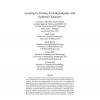Free Online Productivity Tools
i2Speak
i2Symbol
i2OCR
iTex2Img
iWeb2Print
iWeb2Shot
i2Type
iPdf2Split
iPdf2Merge
i2Bopomofo
i2Arabic
i2Style
i2Image
i2PDF
iLatex2Rtf
Sci2ools
AAI
2005
2005
Learning By Feeling: Evoking Empathy With Synthetic Characters
Virtual environments are now becoming a promising new technology to be used in the development of interactive learning environments for children. Perhaps triggered by the success of computer games, VEs are now seen as an emergent and engaging new way by which children learn experimental sciences and other disciplines. Inhabiting these IVEs there can be agents or intelligent characters, that are responsible for events that happen in the environment and make it not predictive or completely controlled. However, to build such environments, in particular if populated by synthetic characters, one needs to carefully address the problem of how do the learners respond to the characters in the virtual environment. Do learners like the characters? Do learners identify themselves with characters in virtual en
| Added | 15 Dec 2010 |
| Updated | 15 Dec 2010 |
| Type | Journal |
| Year | 2005 |
| Where | AAI |
| Authors | Ana Paiva, João Dias, Daniel Sobral, Ruth Aylett, Sarah Woods, Lynne E. Hall, Carsten Zoll |
Comments (0)

